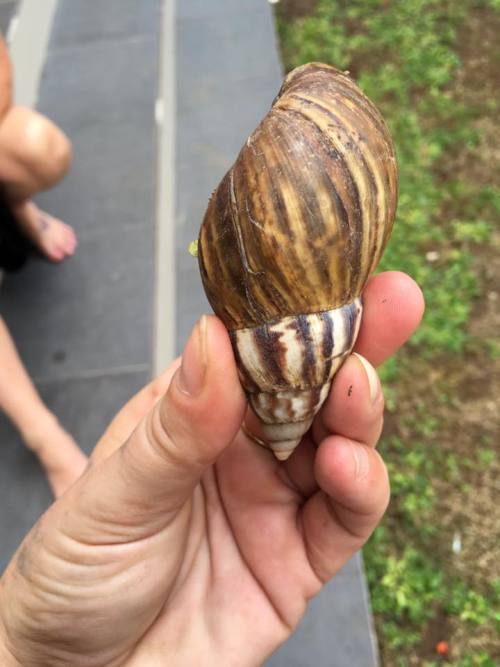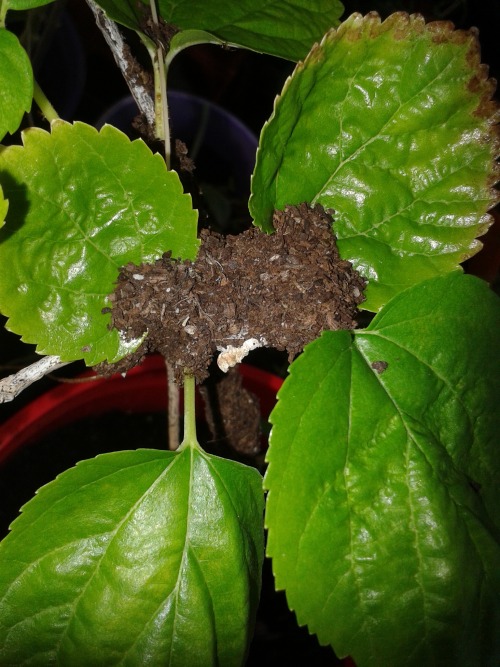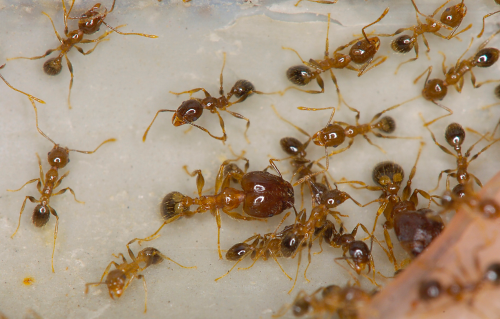#1149 - 1156 - Various IDs for Various Folks
#1149 - Andricus quercusstrobilanus - Pinecone Oak Gall

Photo by @spatheandspadix, the Punk Botanist :) They saw this interesting gall on a Swamp White Oak and my google-fu was strong enough to dig up an ID. Andricus quercusstrobilanus is a Cynipid wasp, but all the photos of that species that I’ve turned up are of the distinctive galls it makes on Swamp White Oaks, Bur Oaks, and Overcup Oaks.
Here’s another Andricus, anyway - cute little nuggets, aren’t they?

Andricus quercusradicis, Wiesbaden, Hessen, Deutschland - photo by Fritz Geller-Grimm
#1150 - Achatina fulica - Giant African Snail

Ange Marie saw this outside her room while in Bali, and it’s quite lucky they didn’t try to bring it home, because it’s horrendously invasive. And threaten native snails. And spread plant pathogens. And spread parasitic helminths and nematodes. Bad news all round, really - which makes their ubiquity in the pet trade an epic facepalm, since they thrive in mild climates as well as in their native West Africa. Also, people eat them, and they’re sacrificed by practitioners of Candomblé.
#1151 - Pheidole megacephala - Coastal Brown Ant
Work sent me these photos - since we do termite control, it was understandable, since termites frequently build covered tunnels so they can access timber above the ground. But these tunnels were built from fragments of mulch, not the usual termite ’mud’. So I did some digging, and got a surprise.



It’s another invasive species, but unlike the African Snails earlier these ones are now firmly established in Australia, and many other countries as well. Also known as Big-headed Ants, because one of the castes of workers have heads many times larger than their sisters.

They were first described by Fabricius in 1793, from Mauritius, but earlier specimens had been collected from Egypt, so it’s unknown were they originated. Colonies can have multiple queens, and form supercolonies as related colonies bud of from the first. They eat dead invertebrates, seeds and honeydew from scale insects and other hemiptera - the tunnels give them access to the honeydew, and protect the insects from predators and parasitoids.
#1152 - Boreoides subulatus - Wingless Soldier Flies

These large flies cause an annual kerfluffle in New South Wales and Victoria, when they show up on walls and verandas, mating and laying eggs - this is just one photo of many that turned up on Facebook, from people after an ID. The male is the one at top. The larvae live on and in decaying vegetation, so compost is ideal.
Despite the somewhat alarming appearance, completely harmless :)
#1153 - Cytaea sp. - Wandering Jumping Spider

Photo by Brian Donovan in Townsville, QLD. Seems closest to Cytaea severa, but might be C. plumbeiventris as well, the Slate-bellied Jumper. Small Jumping Spiders found in Queensland, but probably found in most of the warmer areas of Australia.
#1154 - Tellervo zoilus - Cairns Hamadryad

Photo by Graham Possingham at Mount Hypipamee Crater, in the Atherton Tablelands in Far North Queensland. The crater is a diatreme, with vertical sides close to 100 meters high, made when molten magma forced its way towards the surface, reached shallow underground water, and blew out the overlying rock in a gigantic steam explosion. The crater was discovered by Europeans in 1879, when they almost fell into it.
As for the butterfly - Despite appearances, it’s not one of the Whites (Pieridae), it’s a Nymphalid. Standing on four legs is a clue to IDing butterflies in that family. When a caterpillar, this one feeds on Parsonsia - woody vines of the dogbane family, Apocynaceae. It’s native to Papua New Guinea, adjacent islands, and part of Queensland.
#1155 - Ditaxis biseriata

Photo by Elisha Goldup, at the Gold Coast south of Brisbane. A very pretty little Mantispid Lacewing, limited to the Brisbane area if the Atlas of Living Australia is anything to go by. :)
#1156 - Caenoplana bicolor

Photo by Jo Crosbie in Melbourne, Victoria.
Caenoplana bicolor is a beautiful terrestrial planarian, with yellow and burgundy stripes. Geoplanids are mostly predatory, hunting down snails and other prey and using their mucus as glue and digestive juices, and their eversible proboscis to pierce arthropod prey, or to grasp soft-bodied prey such as earthworms.
Most Geoplanids have a very limited range, and are highly selective about the conditions they’ll live in. On the other hand, a few aren’t so fussy, and have spread widely. Caenoplana bicolor, for example, was originally native to SE Queensland but now found far outside that range. They were probably moved around with potted plants. Another Geoplanid, Platydemus manokwari, also known as the New Guinea flatworm, was introduced to certain Pacific islands to try and control the Giant African Land Snail, and promptly ate every native snail in sight. And spread to dozens of other islands, Puerto Rico, Florida, and France. AND it’s a vector of the potentially deadly Rat Tapeworm. Another Australian flatworm, Australoplana sanguinea alba, and New Zealand Flatworm Arthurdendyus triangulatus, are busy eating every British earthworm they can catch.